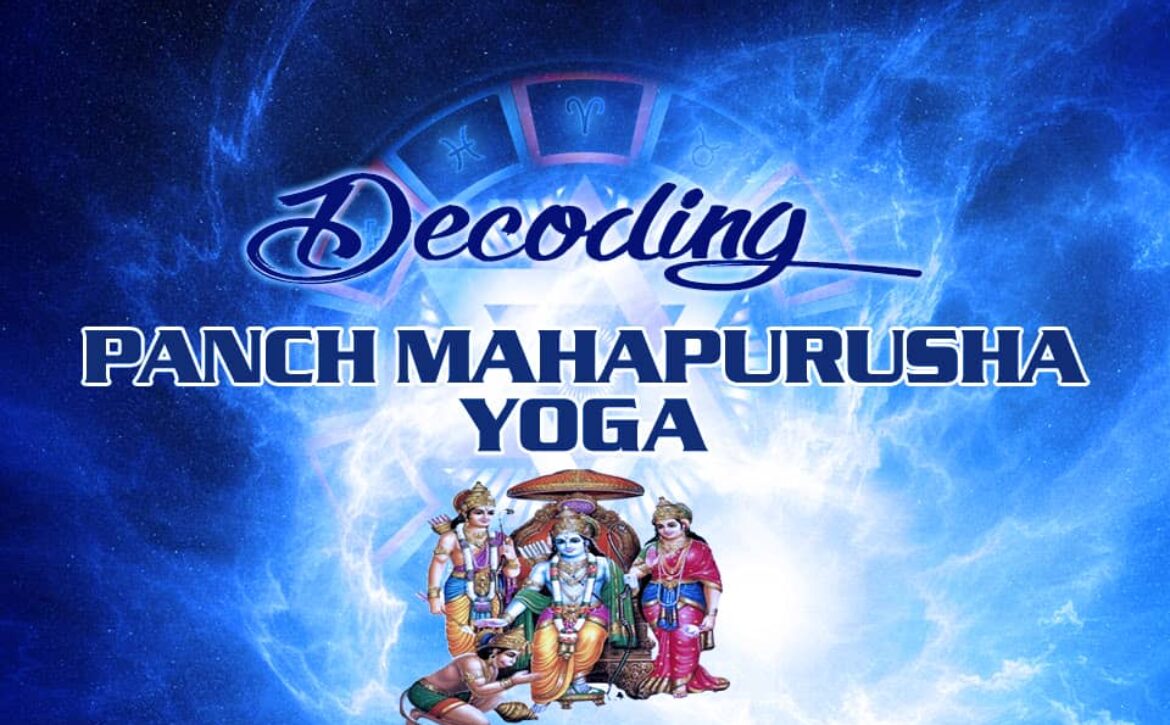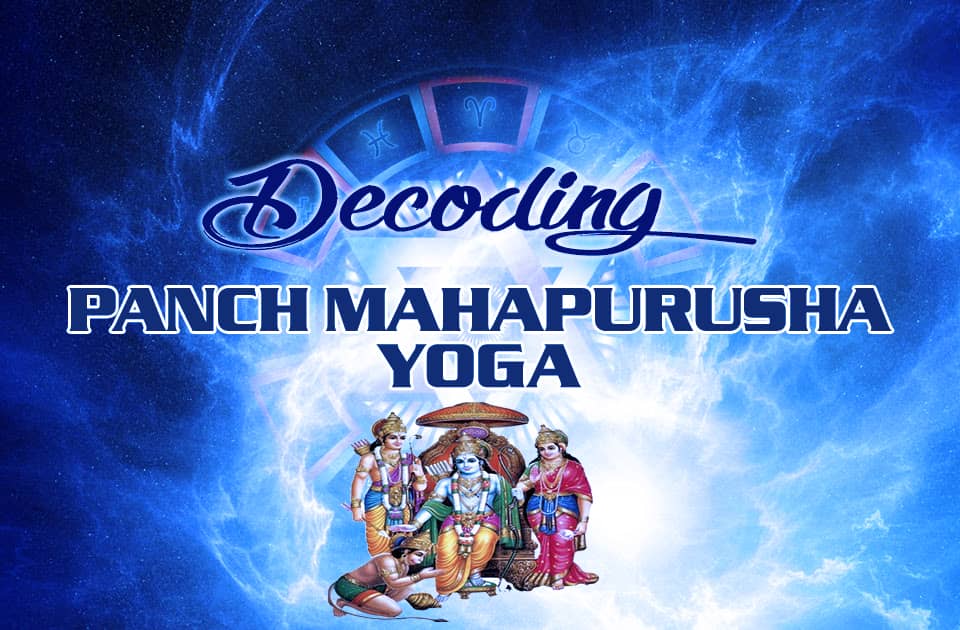Decoding Panch MahaPurusha Yoga
Pancha Maha Purusha Yoga
Written, Analysed and Compiled by Sh. Chandrashekhar Sharma
JyotishTeachings.com
copyright © 2013 Chandrashekhar Sharma
Yoga” is a Sanskrit word derived from the root “yuj” which means to yoke or join, and is used in Vedic astrology to indicate coming together of two or more grahas in a certain manner. There are numerous, and if I may say so, literally thousands of yogas that are given in the Vedic astrology texts. All Vedic astrologers, from the beginners to the most learned know about the “Pancha Maha Purusha” yogas. The yogas are based on the position of five planets and the literal meaning of “Pancha Maha Purusha yoga” is “five types of yogas that occur in birth-charts of great men” In Vedic astrology, we find many yogas having the same name but with different planetary combinations. Pancha Maha Purusha yogas, however, do not seem to suffer from allotment of its name to any other set of planetary combination.
Sage Parashara indicates the primacy of these yogas, by devoting a separate chapter to Pancha Maha Purusha yogas. As the very name implies the yoga arises due to certain positions of 5 different grahas. Sage Parashara describes the combination of grahas, bhavas and rasis that lead to the formation of Pancha Maha Purusha yoga and different names of the yogas related to the grahas causing them, beautifully, as under:
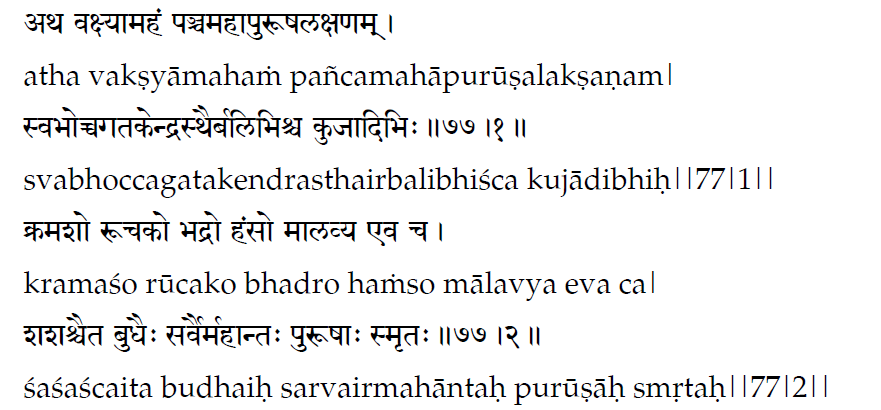
I shall now define the indications of Pancha Mahapurusha. Kuja (Mars) etc. in strength and occupying their exaltation or own rasi occupy kendras, the Ruchaka, Bhadra, Hansa, Malvya and Shasha yoga occur in their natural order (Mangal, Budha, Guru Shukra, Shani).
Let us, now, look at how the individual yogas are said to manifest for the jataka according to Sage Parashara. I have not included the entire shlokas appearing in Brihat Parashara Hora Shastra, here for fear of making the text too bulky. I have only given part of what the Sage says, in bracket, where the indications given by the Sage may appear to be different from the commonly held perception amongst astrologers about nature of certain grahas. I trust this will also help astrologers to refrain from typecasting nature of grahas in a very narrow area, based upon one’s perception of interpretation of scriptures.
Ruchaka Yoga
One born in Ruchaka yoga has a longish face, is over zealous, radiant but polite, extremely powerful and with beautiful eyebrows. He has black hair, is of refined tastes, fond of battlefields and of dark complexion. He is a conqueror, intelligent, has height of hundred finger widths, is of proportionate body and of one thousand Tula weight. He can also be head of theives, of cruel temperament and slender of thighs. He has the signs of Veena (string instrument), Vajra (a type of sword), Dhanush (Bow), Pasha (noose), Chakra (disc) and Vrishabha (bull) signs in his hands. He is a worshipper of Brahmins, expert in Mantras for abhichara. He rules over Vindhya and Sahyadri regions and attains swarga by weapon or fire (dies on account of one of these reasons).
Bhadra Yoga
The jataka of Bhadra yoga is possessed of the radiance of a lion and has a well developed chest. His gait is slow and majestic, like an elephant. He has long and thick arms, is learned, intelligent and skilled in Yoga. He is of Satwa guna, has elegant feet, good moustaches and beard. He is of lustful nature (kamI/kämé) and has marks of Shankha (conch shell), Gada (mace), Shara (arrow), Elephant, Flag and Hala (plough) on his hands and feet. Possessed of a well shaped nose, he is an expert on weaponary, has black hair, is of independent nature and is protector of his family. He is of heavy weight (20 tulas), shares his wealth with friends for luxuries and spends a happy and comfortable life. He rules over Madhy Pradesha (Central region) and lives to 100 years of age.
Hamsa Yoga
Hamsa yoga is caused by Guru (Jupiter) ocupying a kendra, in own or exaltation rasi. A jataka of Hamsa yoga has a voice like that of Hamsa (swan), is fair with elevated nose and beautiful face. He has Kapha humor, eyes that are brown like honey, red nails and is possessed of a high level of intelligence. He has well formed cheek a round head and with beautiful feet he becomes a King. His palms and feet carry the marks of fish, goad (ankusha), Bow, Conch shell, Lotus, bed (khatwanga) etc. He is lusty and his lust is difficult to satisfy by his wife (ôI;u kamataeR nEit tuòtam!,/ stréñu kämärto naiti tuñöatäm|) He is 96 finger width tall, fond of water sports and rules the kingdom spread between the rivers Ganga (ganges) and Yamuna. Living for a hundred years and enjoying all pleasures on this earth, he attains death in a forest.
Malavya Yoga
Malavya yoga is caused by Shukra (Venus) ocupying a kendra, in own or exaltation rasi. A jataka born in Malvya yoga is possessed of beautiful lips, a thin waist and is of moon like (splendorous) complexion. He emanates a good smell, is somewhat fair, of medium structure and possessed of beautiful and clean teeth. His voice is like an elephant and his hands reach his knees. His face is 13 finger width long and 10 finger width wide. He lives upto 70 years of age, rules happily over Sindhu and Malwa countries and attains the abode of gods.
Shasha Yoga
Shasha yoga is caused by Shani (Saturn) ocupying a kendra, in own or exaltation rasi. A jataka of Shasha yoga has small teeth and a small face but is not of short strature (is fairly tall). He is possessed of valour, slim at waist, of beautiful thighs, intelligent and likes to wander over hills and forests. He knows the weak points of the enemies, is the leader of his army, with somewhat elevated (irreregular) teeth and is lively. He is knowledgeable in metallurgy, fond of women and able to usurp other’s wealth. His palms and feet carry the marks of Mala (rosary), Veena (a string
instrument), Mridunga (a purcussion instrument) and weapons. He rules over many parts of this earth with happiness and lives upto 70 years, attaining the abode of Gods.
Having understood the basic definition of the Pancha Maha Purusha Yogas, let us try to understand what makes it possible for such yogas to be able to deliver the results promised and how the results are to be applied to real life horoscopes. I am sure that most of the astrologers, both practising and the students, must have come across many horoscopes that did have the Pancha Maha Purush yogas. I am also sure they must also have been confused when they found that the results of the yogas, as indicated by the sages, have not fructified for many of the jatakas. This is the question that we shall try to address here. I shall try to give my interpretation of this anamoly. Those more knowledgeable than me, may like to find a more suitable interpretation if they think that my interpretation is not the right reason for failure of the Pancha Maha Purusha Yogas to fructify in a chart. As a matter of fact this may be a good subject for research for the learned, who could try to analyze about a 1000 charts in order to arrive at near correct reason for failure of fructification of Pancha Maha Purusha Yogas in a chart. I prefer to rely on the time-honoured method of presentation of any proposition based on Pramana (quotes from authoritative texts) and Tarka (logic) that was acceptable to the sages.
The first thing that strikes me, as it would any astrologer with an inquiring mind, is that even though results of five types of Maha Purusha yogas are given by the sages, each of the five planets can occupy a particular kendra in any of the three rasis, that is two of rasis owned by it and its exaltation rasi barring Mercury, whose exaltation and own rasi being Virgo, it can ocupy two rasis. There being 4 kendras in a chart, this means that there would be a minimum 56 variations of the Pancha Mahapurusha yoga capable of giving different results instead of the 5 results for the yogas, given to us by the sages. Thus each planet, excluding Mercury, can have 12 variations of the Panchmaha purusha yoga caused on its account. Mercury shall have 8 variations of Bhadra yoga caused by its presence in kendra. This will increase to 12 if we consider the exaltation of Mercury based on degrees traversed in Virgo as separate from its occupation of rest of the part of Virgo as a separate variation of the yoga. Should we do that, the total vaiations of the Pancha Mahapurusha yoga would be 60. It is obvious to even a person with reasonable knowledge of astrology, or for that matter any shastra, that the results for all the variations, for a particular planet cannot be identical. If we look at the shloka given by the sage Parashara again, we find that the sage does say that the planets have to be possessed of strength (biliÉí-balibhiçca). I find support in Kalyan Varman when he states in Saravali on commenting on the Pancha Maha Purusha yoga as under:

When the yoga is caused on account grahas like Bhauma (Mars) etc. in strength, one gets kingdom. But if, simultaneously, Suyra and Chandra are bereft of strength then the yoga for kingdom does not occur but one does get progeny and wealth during the Dasha of the yoga causing graha.
Each of the planets, causing any variation of the Pancha Mahapurusha yoga, will be generally treated to be strong on account of occupation of both a kendra and own or exaltation rasi therefore the meaning of strength, referred to here by the sages, needs to be understood in proper perspective. Since each of the planets achieve digbala in different kendra as are they bereft of it in others, it stands to reason that a planet conferring a Pancha Maha Purusha yoga, will not have same amount of strength while posited in any of the 4 kendras that it can occupy. Again we find that the planets involved have ownership of one male and one female rasi and they are themselves either male, female or eunuch. We also know that though shubha planets give greater shubha results when they attain strength, not all ashubha or papa planets have elevated malfeasance as a result of gaining strength. Saturn is said to give least malefic results, when he is endowed with strength and greater malefic results when bereft of strength.
Kalyanvarman is Saravali tells us this unambiguously when he says:

When grahas are strong in a horoscope, related bhavas and their indications (like Atma, Mana, Satwa, Vacha, Gyaana, Veerya and sorrow, as well as the benefic and malefic nature of the relevant grahas) are realized with more and more strength. If the grahas become weak the related indications suffer. In case of Shani reverse is true.
This means that if Shani is strong, sorrow does not increase but it decreases.
Similarly, Guru is said to distort (æò ) or harm one of the indications of the bhava he occupies, so in strength, he might harm the bhava occupied though he will give excellent results of the bhavas that he aspects and good results of the other indications of the bhava occupied. Many modern astrologers find it difficult to accept this position. I have seen the dictum coming true every time. But this being a principle on which there are divergent opinions, I would like to give an old shloka, often quoted by my father and astrologers of his generation, leaving the acceptance or otherwise of the said principle to the better judgement of the learned.
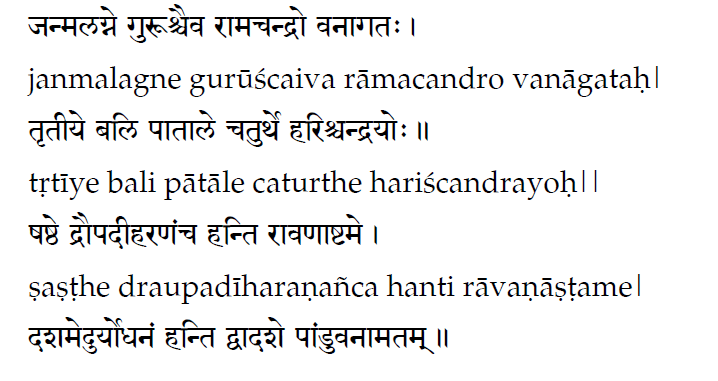
Guru occupying lagna in Lord Rama’s horoscope made him get banished to forests by his father, Guru in 3rd bhava caused the King Bali being sent to Patala (abode of Asuras- netherland under water) by lord Vishnu, 4th bhava occupied by Guru in King Harishchandra’s chart took away his kingdom, Dushshaasana (one of the Kauravas in Mahabharata) tried to strip Draupadi’s clothes on account of Guru occupying 6th bhava in her chart, King Ravana died (in war with Lord Rama) on account of Guru occupying 8th bhava, Guru occupying the 10th bhava in King Duryodhana’s chart resulted in his death at the hands of Bhima in Mahabharata, and Pandavas were sent to forest on account of their defeat in Dyuta (a type of gambling game of the Kings) on account of occupation of 12th bhava in Yudhishthira’s chart.
So the interpretation of the Pancha Mahapurusha yogas will have to be modified taking into consideration these additional factors. Next are the injunctions about some of the planets being incapable of giving (beneficial) results in certain kendra positions. The two benefic that come to mind are Mercury in the 4th and Venus in the 7th bhava.
Jataka Paarijata says:

Budha in the 4th house, Guru in 5th house and Shukra in 7th house, cause trouble to those houses. Shani gives good results in the 8th house.
So, even here, the results of “Pancha Mahapurusha” yoga would not be felt prominently and in accordance with the texts. Similarly, Mars in 7th, Saturn in Lagna, Mercury in the 7th bhava are said to be in Marana sthanas if aspected by or associated with malefics or grahas in debility as indicated by the definition of Maranasthana given in Jataka Parijata:
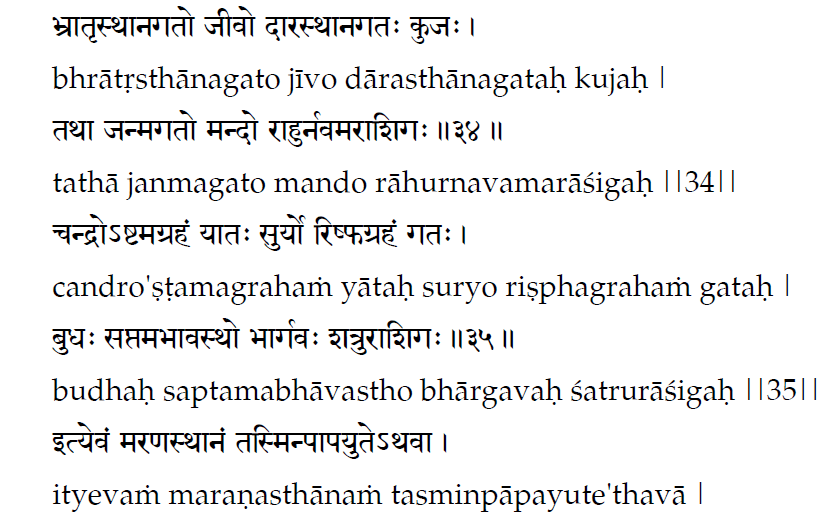
For Jupiter the 3rd house, Mars the 7th, Saturn the Lagna, Rahu the 9th, Moon the 8th, Sun the 12th, Mercury the 7th and for Venus the 6th house are called the marana sthana. If these planets, placed there, are also aspected or conjoined by a malefic or debilitated planet, an indication of these sthanas are harmed. One should understand that if the planet so aspecting/conjunct is only malefic some bad indication of the Marana bhava are experienced, and when the malefic is also an enemy of, or in debilitation, more harm to the indication of the Marana sthana house indicated.
So these grahas, in those sthanas (house/place), may again not deliver the results of Pancha Mahapurusha yoga, regarding making one a king over large tract of land in a chart, if aspected or conjunct malefics. Thus we find many reasons that could result in the Pancha Mahapurusha yoga not getting fructified. It is interesting to see the opinion of Mantreshwara, in Phaladeepika, regarding Pancha Maha Purusha Yogas.

If these grahas (capable of giving Pancha Maha Purusha yoga) are also placed in kendra from Chandra (moon) simultaneously, the yoga becomes capable of making one an emperor and possessed of great bhagya (luck).
He has initially given different results of the “Pancha Mahapurusha yoga” that exclude becoming a king of the level indicated by Parashara, barring in a few cases. He then goes on to say that if the graha causing the Pancha Maha Purusha yoga also happens to be in kendra to Chandra simultaneously, such as yoga is capable of bestowing Samrajya (becoming an emperor) and great bhagya(luck). Mantreshwar’s opinion appears to be based on very logical application of principles of Vedic astrology, since Chandra will be getting sthana bala, occupying a kendra, and will be paraspara karaka to both the lagna and the graha concerned the results would be more prominent.
There is another matter that needs attention of the learned and that is about what happens when more than one Pancha Maha Purusha yogas is present in a chart. As in many matters of astrological principles, there are two opinions here too. One school of thought thinks that all the yogas will fructify in the dashas of each of the planets causing the multiple yogas in the chart. Another school of thought is of the opinion that only the strongest of the multiple yogas will fructify in that particular graha’s period. I tend to agree with the later opinion, as I do with the opinion of Mantreshwar about the yoga causing needing to be in kendra to both Lagna and chandra to give a large kingdom to rule over, or its equivalent power to be wielded by the jataka.
Let us look at the chart of Lord Ramachandra, generally accepted to be the right chart by astrologers, to find out whether this principle applies.
Horoscope of Lord Ramchandra
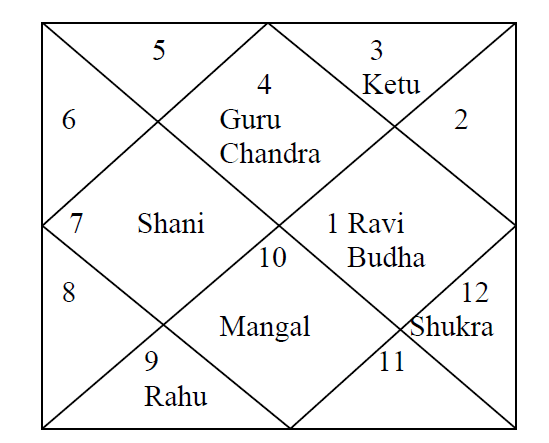
We observe, here, that there are three “Pancha Maha Purusha” yogas in the chart that is:
1) The Hamsa yoga caused by an exalted Guru occupying Karka (cancer) rasi, in Lagna.
2) Shasha yoga caused by Shani in exaltation occupying Tula (Libra) rasi in the 4th bhava
3) Ruchaka Yoga caused by exalted Mangal in Makara (Capricorn) rasi ocupying the 7th bhava
Amongst these, the condition of the grahas causing Pancha Maha Purusha yoga of being in kendra to both Lagna and Chandra is satisfied as Chandra occupies the Lagna. So, there is hardly anything to choose between the grahas to give an indication of how and which of the yogas will fructify. However we find the Parashara injunction of the graha with strength giving rise to the yoga unfolding here. We find that Guru is possessed of full digbala occupying the lagna which is rasi of its friend and in exaltation, whereas Shani is with 50% digbala and Mangala is not only with 50% digbala but also occupies its marana karana sthana and whereas Saturn occupies the house of its friend, Mars occupies rasi of its sama/neutral graha. We also observe that Shani is lord of the 7th and the 8th ,both Dusthanas, thus weakening the effects of its occupation of a kendra as the 8th lord weakens the house it occpies and 7th bhava is Maraka sthana. Mangal could have qualified for the yoga by reason of being the 5th and 10th lord and therefore a yoga karaka but for the fact of its occupation of its Marana sthana.
We are also aware, of the basic Parashari dictum, that if either an exalted or debilitated graha aspects the lagna, Raj Yoga takes place. Thus lagna and by implication its lord Chandra become strong, concentrating all strength in the yoga occuring in the Lagna. That dispositor of Guru, Chandra occupies own rasi in a kendra and is possessed of Paksha bala also renders strength to the effects of Guru. So there is no doubt that Guru will give the Pancha Mahapurusha yoga attributed to it which is the Hamsa yoga.
However, as we discussed earlier, Guru who caused the Pancha Maha Purusha yoga also resulted in Lord Rama being banished to forests by his father (Guru is lord of the 9th). We also see here
that Saturn, the slow one, aspecting the Lagna and Guru caused the results of the yoga to fructify at a late stage in Lord Rama’s life. That Mars also aspects the said Guru also indicated the difficulties that the Lord had to face before the yoga fructified for him. There are also many other implications of the planets in the chart, but I am sure I need not explain them to this gathering of knowledgeable astologers. I hope this analysis of the chart of Prabhu Ramchandra will help illustrate to the students, as also the learned, why even with powerful Pancha Mahapurusha yoga present in a chart, it is better to analyze the horoscope in its entirety, before looking at the final results that the yoga is likely to deliver to a jataka.
The reason is that in the horoscope of Lord Ramchandra, since there are multiple Pancha Mahapurusha yogas, the yoga in his chart which is in strength only fructified and he ruled over a kingdom between Ganga and Yamuna rivers, as indicated in the indications of Hamsa yoga, by Parashara.
At this point of time I must make it clear that it is not necessary that a jataka of Hamsa yoga will always rule over that region. The regions are only indicative of the directions related to a strong graha taking a person to its own direction at the time of operation of its dasha. Even here it may be the dispositor of the graha causing the yoga or its Navamsha dispositor’s position that may have to be considered if we are to follow the astrological principles in their entirety. One must remember that Vaidyanaath in Jataka Paarijata gives different regions and so does Mantreshwara in his Phaladeepika. That lord Ramchandra did rule over the area indicated by Parashara may in fact indicate that he ruled the kingdom in the northeast direction of the known world, at the time of his rule, as Guru does indicate the Northeast. I would like to enjoin upon astrologers, at this point of time to try to understand the principles being given by the sages instead of insisting that the yogas occur verbatim since they are so given by Sage “A” or by Sage “B” as is the fashion these days. Astrologers can understand this best in discussions of Pancha Maha Purusha Yogas as we find Kings in other countries who do have Pancha Maha Purusha yoga in their horoscopes.
Let us see the Chart of Sadaam Hussain, the ruler of Iraq, who could be equated to ancient day kings.
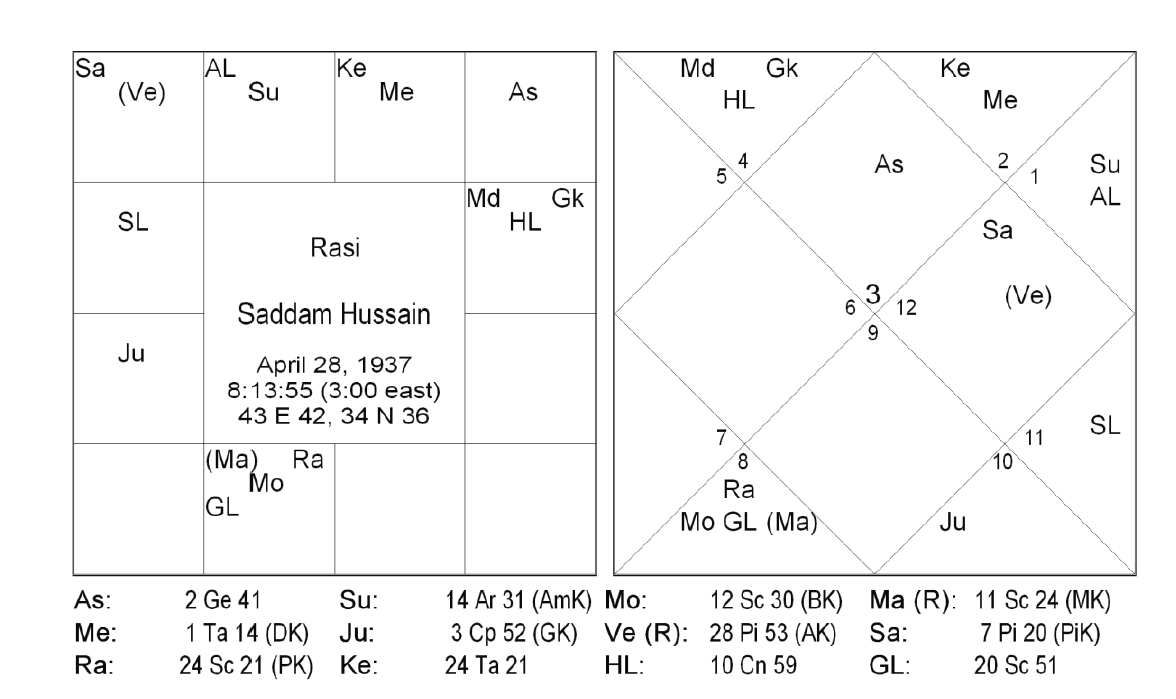
We see here that Shukra occupying the 10th bhava and being in exaltation causes the Malavya Yoga. He ruled Iraq, certainly not mentioned as amongst the countries indicated in the classics. Yet the Yoga did operate. We find Saddam becoming President of Iraq in 1979 when the Maha dasha of Shukra and antar dasha of Shani was operating. According to Ududaaya Pradeep, Shani gives results of Shukra in its own Antar dasha within the Mahadasha of Shukra and the Malavya yoga thus fructified at the right time. There are many other yogas in the charts, no doubt, however, for the present we are only concentrating on the Pancha Mahapurusha yoga occurring with the variation that the graha causing it is conjunct other graha.
Let us now look at another chart of a king, with Ruchaka yoga and Shasha yoga occurring simultaneously in the chart. The chart belongs to King Alexander I, the Czar of all Russia.
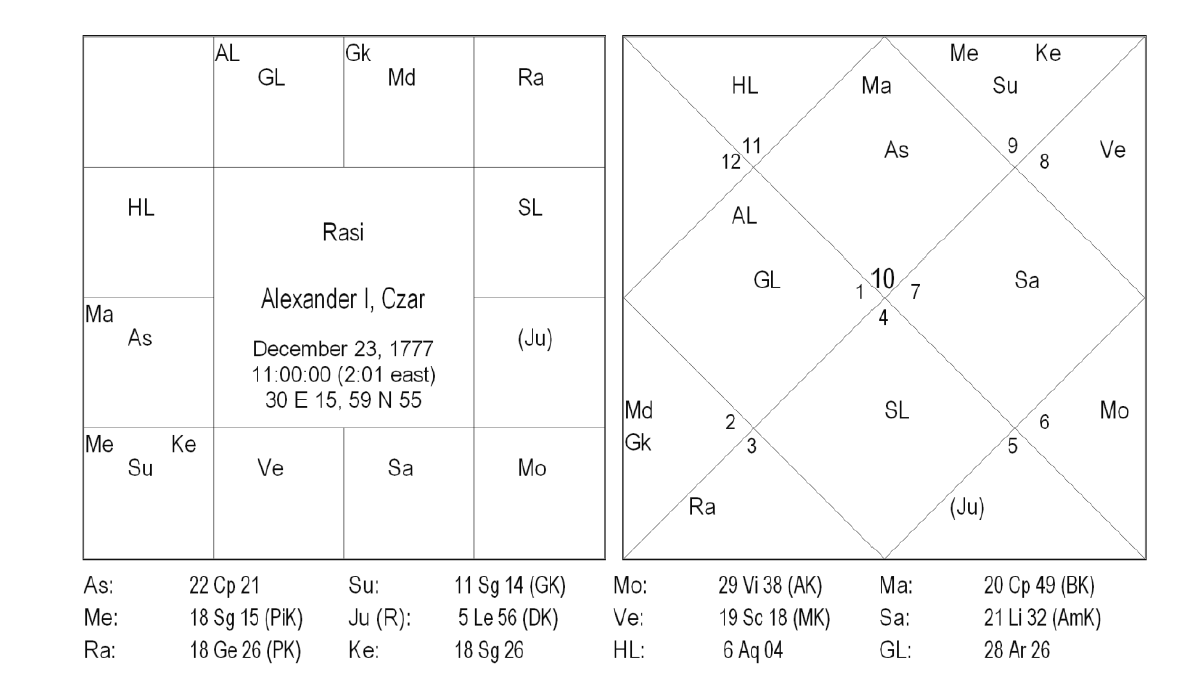
We again find him getting to rule Russia, not mentioned in the texts. So I would advise caution in basing one’s predictions on literal applications of any results that are given for the jataka in any of the many numbers of yogas that are given in classics on astrology. The sages gave certain principles that are to be applied with viveka to a chart. The specifics mentioned in the yogas are by way of illustration of the strength of the yogas and this must be understood by all of us.
We observe that both Mangal and Shani are of almost equal strength, though Shani is endowed with more strength as it occupies the most powerful of the kendra in the rasi of its bosom friend, whereas Mangal occupies rasi of a graha that is “Sama” to him. We also observe that Guru aspects the Mooltrikona of Shani strengthening it and, by implication, its lord Shani who also happens to be the lagna Lord. Alexander the 1st ascended the throne in March 1801 on the death of his father Czar Paul I on 12th March 1801. Pratyantar dasha of Rahu was running at that time and we know “Manda sama Rahu” thereby giving results of Shani and operation of Shasha yoga in his case.
It is interesting to see that in both the cases the jatakas did not enjoy kingdom till end of their life, Saddam being deposed and Alexander I, Czar of Russia, is rumored to have left for Serbia to become a Hermit. What we see common here is that in both cases the Pancha Maha Purusha yogas occur only from Lagna and Chandra is not in kendra from lagna and the grahas. Thus this may support what Mantreshwara tells about the yoga gaining strength if it is simultaneously occurring with respect to Chandra as it does with respect to Lagna. I would be the first to admit that this sample size is too small to come to a definite conclusion. However this is one area that the learned may like to explore with support of data of jatakas in similar circumstances with charts numbering at least 200 or more to come to any definite conclusion. That the sages, in connection with any of the Pancha Maha Purusha yoga, have not mentioned these countries and yet the yoga has given them rulership over a country is supportive of my contention that the sages gave us certain principles that must necessarily be applied with viveka (sense of proportion).
Before I close, I give a shloka from Chandra Kala Nadi for the learned to ponder over:

When Shani aspects or conjoins Guru, then the results of Malavya yoga are not realized. The effects of Shukra being in exaltation are harmed on account of harm caused by the graha (Shani – but I think this may also include malefics).
This is the translation that appears in Chandra Kala Nadi AKA Deva Keralam. This is a very interesting concept since at first glance, there is no harm to the house occupied by Shukra or Shukra himself, barring, when Shukra occupies the 10th bhava, and yet the yoga does not fructify on account of conjunction or aspect between Guru and Shani. It is interesting to note that the exaltation state of Shukra is being referred to here, indicating, perhaps that the author of the Nadi did not give much weight to grahas occupying kendra in own rasi for considering occurrence of Pancha Maha Purusha yoga, restricting himself only to graha in exaltation in kendra when considering the Pancha Mahapurusha yoga.
Personally, I think that the reference is to Shani being placed in the 8th bhava which is also referred to as the Cchidra bhava, while aspecting Guru and Shukra in exaltation causing the Pancha Maha Purusha yoga is the condition about which the nadi author is talking. If we accept my premise then Shani will be aspecting the 10th ,the 2rd and the 5th bhava of the chart in either of which Guru will have to be placed in order to get aspect of Shani. With Guru’s nature of harming the bhava occupying and Shani doing the same with aspect, it is easy to see why the Malvya yoga caused by Shukra occupying its exaltation rasi will be broken.
Further analysis will show us that the lagna will have to be of one of the rasis owned by Budha or Guru, for Shukra to cause Malavya yoga while occupying its exaltation rasi. So in this case, Guru will be attracting Kendradhipati dosha and Shani will own at least one of the trika, trishadaya or Maraka sthana, thus the harm to the houses to which they relate would be greater thus causing the Malavya yoga to break. We also observe that Shukra will also own one dusthana with these lagnas.
Another interpretation of the word Cchidra could be the 9th bhava as the word refers to the nine Cchidra of the body. In that case, the indication is occupation of a trine from Shukra causing Malavya yoga being occupied by a malefic causing the yoga going waste. Personally I think that this principle of a malefic in trine to a graha causing a yoga wasting away the results obtained on account of that yoga, can be applied to other grahas as well. We can see the operation of this principle in charts of both Saddam Hussain and Alexander I Czar of Russia.
An additional reason for Shani conjunct or aspecting Guru causing break of Malavya yoga appears to be connected with the fact of Shani alone in 9th bhava and unaspected is said to lead to Pravrajya and aspect of Shani on Guru is also said to be indicative of one who is more focused on improvement of one’s soul, at the very least, if not pursuit of knowledge of the Para Brahman; than on one’s bank balance.
The wording of the shloka, to me, appears to suggest that the jataka will get the results of the yoga but would cause it to go waste on account of his own deeds or way of thinking.
I thank all of you for having given the patient reading to my thoughts on Pancha Maha Purusha yoga and would like to submit that these are my personal thoughts and those more knowledgeable than me may hold a different view on this subject. If I cause the learned to think about the texts in more depth, instead of only memorizing the texts, I would have succeeded in my efforts to bring more rationality to this divine science of Vedic Astrology.
Note: Article is orignal written by Chandrashekhar Sharma ji and viewers can Read it from here http://www.jyotishteachings.com/articles.html
Regards,
Chandrashekhar Sharma
Om Tat Sat
Views: 621

